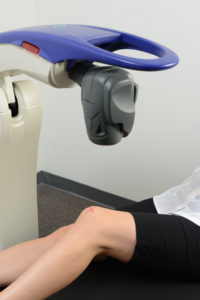The American Academy of Orthopaedic Surgeons (AAOS) recently updated their guidelines for osteoarthritis of the knee joint for the first time since 2013 to now include laser therapy as a recommended treatment option.
The AAOS guidelines serve as an educational tool to help providers build treatment plans by sharing extensive information on approaches proven effective in practice.
According to the updated guidelines, “Patients should expect to experience improvements in pain and function with the treatment. There have been no reports of serious side effects from laser treatment for pain control.”
Laser therapy—sometimes referred to as photobiomodulation—is a non-invasive therapy that uses light energy to favor and accelerate the body’s natural healing processes. Photons penetrate the tissue and cause different biological effects at the cellular level to promote tissue regeneration, improve blood circulation, reduce inflammation, and relieve pain.
For arthritic conditions, laser therapy can reduce inflammation surrounding the joint, relieve pain, and improve mobility and range of motion.
This is exciting news to the over 14 million Americans suffering from knee osteoarthritis. As more patients begin considering non-invasive and non-pharmacological solutions for acute and chronic pain, alternative approaches like laser therapy are growing in popularity.
 Following these updated guidelines, experts expect tremendous growth in laser therapy as more providers and their patients recognize its benefits. Additionally, as therapeutic laser technologies continue to advance, they are becoming more efficient in their biological effects and applicable to a wider range of indications.
Following these updated guidelines, experts expect tremendous growth in laser therapy as more providers and their patients recognize its benefits. Additionally, as therapeutic laser technologies continue to advance, they are becoming more efficient in their biological effects and applicable to a wider range of indications.
The Multiwave Locked System®, a unique type of Class IV laser emission system, exceeds the limitations of traditional low-level laser therapy while avoiding the concerns of early generation high-power Class IV lasers.
With a synchronized dual wavelength system, the MLS Therapy Laser provides an immediate, simultaneous, and long lasting effect on pain and inflammation. Studies suggest that the MLS pulse has a greater effect on pain and inflammation associated with knee osteoarthritis than single-wave laser irradiation.
With a penetration depth of up to 5 centimeters, the patented MLS emission system is ideal for stimulated biological effects deep within the knee joint.
At the chiropractic practice, laser therapy can offer DCs another tool in their arsenal of holistic pain management modalities for knee pain and other degenerative, inflammatory, musculoskeletal, and/or neuropathic conditions.
Learn more about the benefits of MLS Laser Therapy to the Chiropractic practice.



